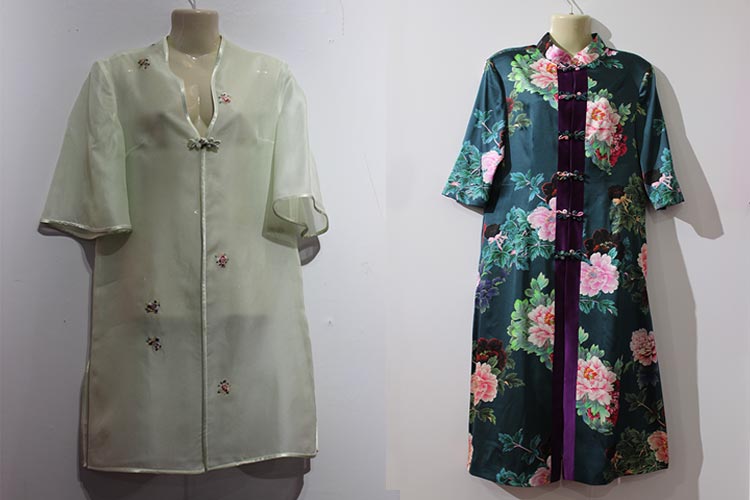Written by: Aiman Javed
Posted on: September 25, 2017 |  | 中文
| 中文
(L - R) Chinese bag, cheongsam and shoes
An exhibition of traditional Chinese costumes, titled the “New Silk Road,” was inaugurated at the China Cultural Centre, Pakistan National Council of Arts (PNCA) on Sunday, 24th August, 2017. The chief guest, Mr. Junaid Akhlaq, Joint Secretary of National History and Literary Heritage Division of Pakistan, began the opening ceremony by addressing the rise in cultural exchanges between Pakistan and China. He said, “Exhibitions such as the Chinese Silk, Porcelain and Tea one last August, and now this one, reveal the eagerness of the Chinese for increasing cultural connectivity with Pakistan.” The Cultural Counsellor from Chinese Embassy of Pakistan, Mr. You Yi, spoke about the elegance of Chinese costumes, which strongly emphasize usage of silk and embroidery. While, silk cloth was first developed in ancient China, embroidery such as Su double-sided embroidery is unique to China. Besides other dignitaries, a team of artists from China also attended the ceremony, including fashion designer Ms. Cui Shumin.
The students of Roots School System gave a presentation on cultural facts about China and Pakistan. Their Chinese language teacher and four students then performed a Chinese song, using traditional umbrellas as props. Other students sang a song, with Urdu and Chinese lyrics, about Pakistan-China friendship. Students of Iqra University were also present at the occasion, having helped arrange the exhibition.
With the end of the opening ceremony, Ms. Cui Shumin guided the guests around the gallery, explaining the material and style of the costumes, and the work on each particular item. Raw, pure, jin (polychrome woven) and juan (watered) silk had been used to make the clothes, with only a few items in velvet. Besides intricate hand-embroidery, hand painting had also been used to adorn the garments. Having designed most of the clothes herself, Ms. Cui clarified that these were contemporary versions of traditional costumes, and thus could be utilized in modern times. Shoes and accessories including bags, wallets, scarves and necklaces, were displayed as were handheld fans with double-sided embroidery, and frames with embroidered sceneries.
Some of the clothing was inspired by Han dynasty (206 BC–220 AD) costumes, which are characterized by closed collars and A-line shirts. Influences from the traditional ruqun of Tang dynasty (618 – 907) were visible, in the form of short upper shirts and flowing long skirts. Numerous cheongsam, a figure-hugging one piece dress, which originated in Qing dynasty (1644-1912), were being displayed. The most expensive item of all was a white cheongsam, with hand embroidered flowers. In men’s clothing, all of which were inspired by Han dynasty costumes, a ceremonial red shirt was identified as an item only worn by men above the age of 60 on their birthdays. Tea culture clothing, worn during tea ceremonies, was identified by its diagonal buttons. Most of the clothing was for females, with only a few items for men. This reflects modern day Chinese clothing trends, since women tend to wear traditional clothes on formal occasions, but men have adapted to more Western costumes.

A pure silk scarf was gifted to Mr. Junaid Akhlaq’s wife by Ms. Cui Shumin. The attendees then enjoyed the high-tea arranged for them on the ground floor of PNCA. The exhibition will carry on until 18th October, and some items may be put up for sale in the last few days.
You may also like: